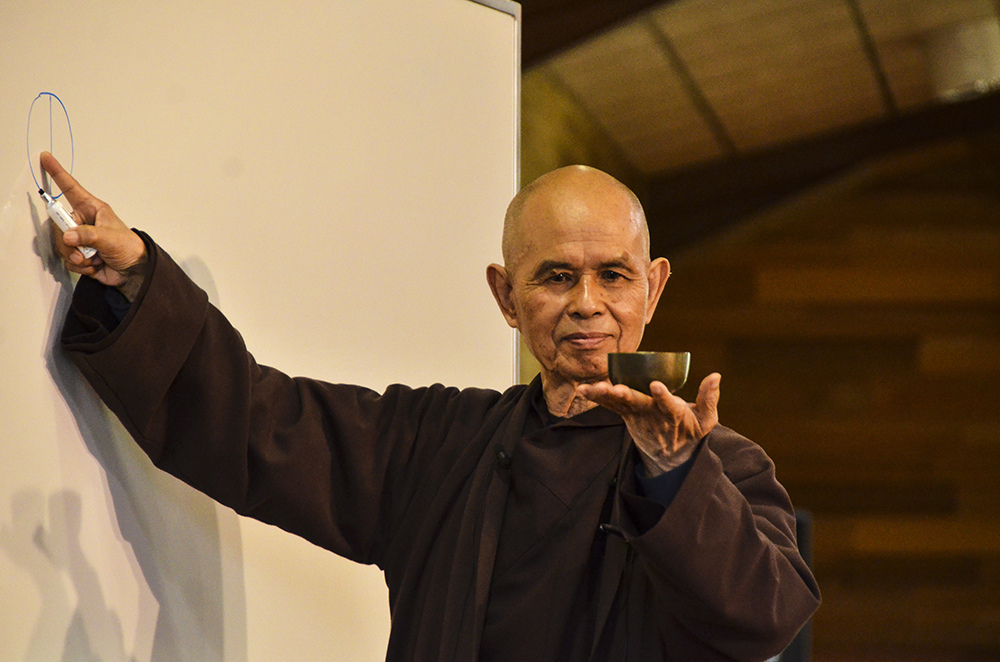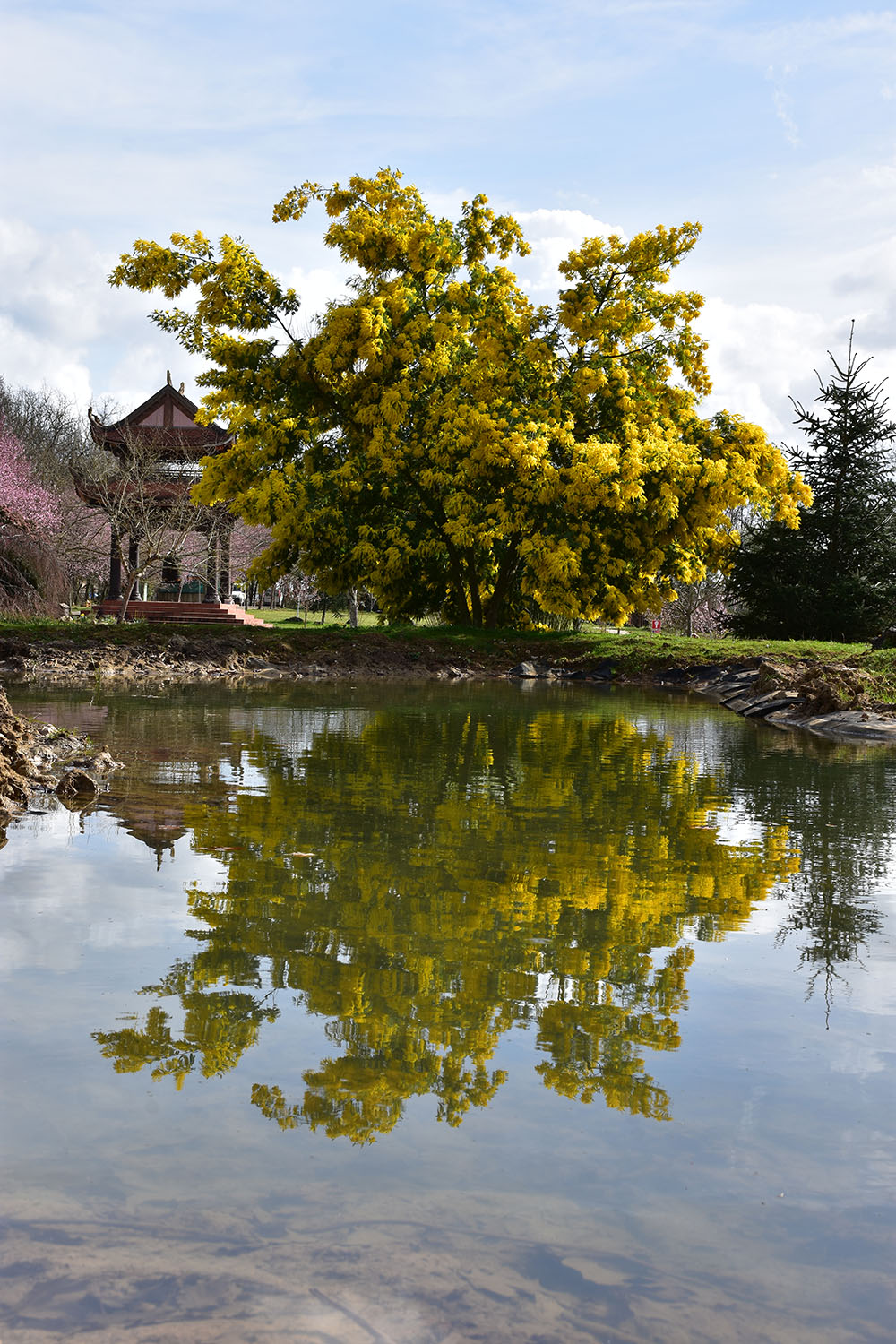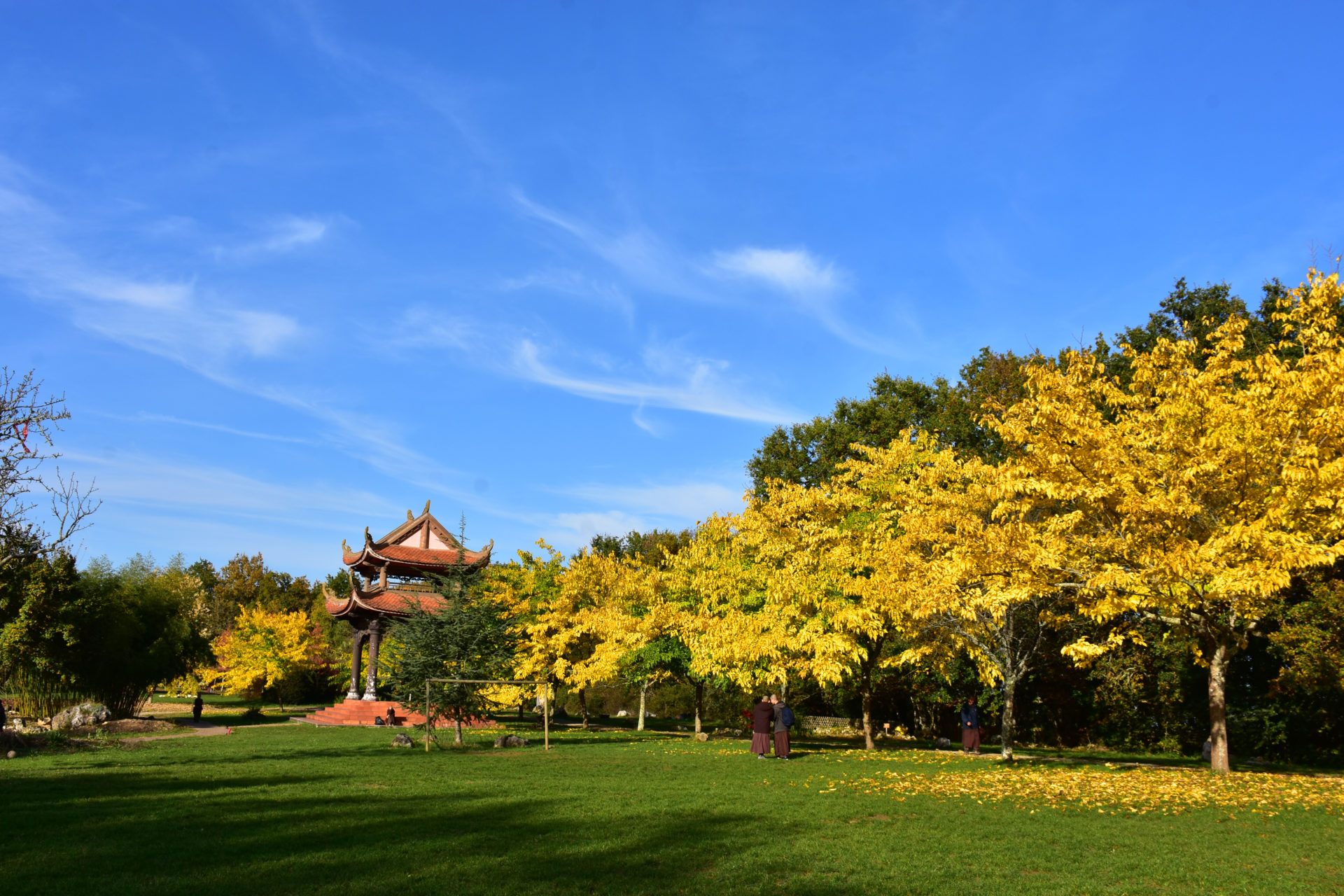Excerpts of a Dharma Talk
By Thich Nhat Hanh

Green Mountain Dharma Center, Vermont
May 17, 2001
Being a member of the Order of Interbeing is to have an opportunity to practice going home to our ancestors, to our children, to true peace and compassion.
When you are accepted as a student at a university,
Excerpts of a Dharma Talk
By Thich Nhat Hanh

Green Mountain Dharma Center, Vermont
May 17, 2001
Being a member of the Order of Interbeing is to have an opportunity to practice going home to our ancestors, to our children, to true peace and compassion.
When you are accepted as a student at a university, you are given a student identification card that gives you access to the library, the classroom, the teachers, and so on. If you show your card and say, “I am a student of that famous university,” it only means you have an opportunity to study at that school. Being a member of the Order of Interbeing is the same. We have an opportunity to have access to teachers, Sanghas, and methods of practice. If you don’t fully profit from this access, what is the use of your ordination?
The Fourteen Mindfulness Trainings are to be applied to daily life. If you find that the practice cannot be integrated in your daily life, then something is wrong with your practice. The Fourteen Mindfulness Trainings are concrete expressions of engaged Buddhism. Compassionate listening and loving speech are part of that teaching and practice. If you practice compassionate listening and loving speech, you should be able to restore communication, to make it flow again, to reduce the level of suffering, to create smiles and happiness. Whether you are in a family setting or at your workplace, that practice is possible.
The president of a big corporation in America told me that he is proud he has more than fifty directors who are dynamic and who work wholeheartedly for the corporation. But then he heard me say in a Dharma talk that the ruin of a nation begins in the family of its people. If the family is broken and communication is impossible in the family, then whatever you do will not lead anywhere. After that, he confessed that over thirty of these directors have divorced their wives and have suffered deeply in their relationships.
A member of the Order of the Interbeing is supposed to be a bodhisattva—a person animated with the energy of love—willing to do something for the world; to lessen the suffering; to create more opportunities for communication, for reconciliation, for understanding, for love, and for peace. If you are motivated by that deep desire to serve, you are already a bodhisattva. A bodhisattva may still have suffering within herself. But with her practice, she becomes a greater and greater bodhisattva every day because she knows how to recognize, embrace, and transform the suffering within herself. But if she neglects that basic practice and gets too busy working, then she is only taking refuge in the work; she does not confront her own problem, which is the block of suffering, despair, anger, and violence within herself.
I have seen young bodhisattvas, sometimes just twelve years old, who are happy practitioners. Such young bodhisattvas do not need an ordination and do not need to have the title of Dharma teacher to make people around them happy every day. They don’t care about the future; they don’t care about the past; they enjoy deeply the Sangha and the practice in the here and the now. They are flowers blooming in the Sangha. Maybe they aren’t aware of it, but they are great bodhisattvas. We treasure their presence.
There are people who have been trained for twenty or thirty years, but they do not have that capacity of living happily and communicating freely with other people. The knowledge of Buddhism is not very useful. There are scholars of Buddhism whose capacity of serving is limited. There was a gentleman who came from England and wanted to be a Dharma teacher. He asked me, “Thay, when do you think we are ready to be teachers?” That was during a cold winter day in Plum Village. I looked at him, and I said, “When we are happy.” That disappointed him a lot. If you are not happy, if you have a lot of anger and fear in yourself, you do not have much to share as a teacher—especially when you think of yourself as a teacher. These young bodhisattvas don’t think of themselves as teachers. Although they don’t have the title, they are the real teachers.
All of us have had that kind of experience. You can see that our children are our teachers; you can learn many things from them. A good teacher is capable of recognizing the presence of a teacher in his or her disciple. Out of that recognition, there is trust. This person will be a good teacher. Not because of his talent to speak or to give Dharma talks, but because the way he lives his life is an example to everyone. You teach with your life and not with your talk alone. Again, action should be based on being. Being peace is the foundation. Doing peace must be based on being peace. Mahatma Gandhi said, “My life is my message.” That is good because my life is the teaching, not just what I do or what I preach.
I visited Deer Park Monastery and talked to a number of monks and nuns about Sangha building. One day I met Sister Thang Nghiem. She had just returned from the root temple in Vietnam. Ten monastics from Plum Village were able to spend twenty‑one days and were greatly nourished at the root temple. They came home much stronger and are inspiring to many other brothers and sisters. I asked her about Sister Gioi Nghiem, who was also on the trip to Vietnam. She remained silent for maybe half a minute, a long time.
Then looking up, she said, “Thay, it’s so easy between me and Sister Gioi Nghiem. We love each other deeply, and the communication between us flows easily; that is why everything is easy with us. Whether we need to do something or discuss something, it’s very quick, and agreement comes quickly.” She meant that when there is good communication, mutual understanding, love, and trust, nothing is difficult anymore; you can move a mountain. She did not use those words, but that was the spirit of her answer.
To be talented in organizing, that is good, but that is not basic. To build a good structure for the community, that is good, but that is not basic.
The basic thing is to receive and bring the practice into our daily life. The Buddha said, “The teaching is lovely in the beginning, in the middle, and in the end.” If it is the right practice, then it can bring relief and joy right away. The moment you begin to breathe in, you can let go of many things, and you go back only to your in‑breath. Concentration and mindfulness can be born just like that. You generate the energy of calm and concentration in your body and your consciousness. There’s a difference, maybe a big difference, between the moment before the in‑breath and during the in‑breath. That is what is meant by “the Dharma is lovely in the beginning.”
Our practice should be our normal life. While we prepare our breakfast in the morning, that time is the time of practice. Peace, concentration, and mindfulness should be generated during the time of breakfast‑making. If you prepare breakfast that way, you become a flower for your family and your community. It’s so pleasant to see someone living deeply in mindfulness and practicing naturally. That person is free from regret and sorrow concerning the past. She is free from fear and uncertainty concerning the future. She is really there, fully alive in the present moment, and she is making breakfast. How wonderful. That’s enough to make the whole family and community happy. You don’t have to go to the meditation hall to practice.
Last night, our friends Thu and Anh Huong arrived from Virginia. Anh Huong went into the kitchen, and a number of friends greeted her. She knew everyone except Sister Hoc Nghiem, who was celebrating her one-year birthday as a nun that day. Sister Hoc Nghiem stood up and said, “My dear sister, I am Su Co Chan Hoc Nghiem,” introducing herself to Anh Huong. Introducing yourself is an ordinary thing to do. You want to make acquaintance with that person; you want to be in good relationship with that person, so you introduce yourself.
But she introduced herself in such a way that Anh Huong felt deeply moved, to the extent that the baby nun in her had a chance to manifest. It was not a Dharma talk; it was not a diplomatic effort to win the heart of someone. It was just an introduction: “Chi Anh Huong, this is Sister Chan Hoc Nghiem.” But her whole body, her whole mind, and her whole presence opened like a cherry tree full of blossoms. I don’t think she made any effort. That is her practice, very natural. Everything you do and everything you say during the day can be a deep practice. If you follow that spirit, transformation and healing within yourself will take place in no time at all. Transformation and healing in your family will take place in no time at all. You become the source of inspiration, the base of action for society.
There are many Dharma teachers in the monastic community, and I know them quite well. Those who can be teachers of Dharma teachers don’t have to practice a long time to be a good Dharma teacher. Their seniors may be Dharma teachers, but some of them don’t practice as well as the younger ones. But that does not prevent the younger ones from addressing their elders with deep respect. They know that although their elders received the lamp transmission several years previously, they still have difficulties within themselves. No complex, no arrogance: I am a younger brother; I am a younger sister; I would like to play the role of a loving young brother or a loving young sister to my big brothers and big sisters in the Dharma. There’s no complex of superiority.
In the teaching of the Buddha, to think of yourself as inferior is a kind of sickness. To think of yourself as superior is also sickness. According to the Buddha, to think of yourself as equal is also sickness because these three complexes are built on the notion of self. If you consider yourself to be a separate self from your sisters and brothers, you are still sick with a disease called self-attachment. When you see your sister is you or your brother is you, then you are in your brother and your brother is in you. Only at that time are you free from sickness. I think psychotherapy has to learn from this. Any teaching and practice that is still based on the notion of self cannot liberate people.
Self‑esteem is a form of sickness. High self‑esteem is a sickness; low self‑esteem is a sickness; and equal self‑esteem is also sickness. Only the insight of interbeing can free us from sickness: You are me, and I am you. “I transform my garbage, so you won’t have to suffer; you cultivate the flower (in you), so that I will be happy.”

There are Dharma teachers who are wonderful, talented, and effective, yet humble and loving without any discrimination within themselves. These teachers can be very young. They don’t mind having teachers who are not as effective as themselves. If the other person is a good teacher, I enjoy that. If the other person is not such a good teacher, I hope that she will do better. Because you have that kind of insight, you don’t have to suffer at all. You will not say, “How could such a person receive the lamp transmission to be a teacher?” In fact, there are those who have not received any transmission and who never desire a lamp transmission, but they are also wonderful teachers. There is a poem in Chinese:
“The novice gives a Dharma talk And the venerable bhikshu sits quietly and listens.”
It’s not the age or the studies that count but the nature of the Buddha in us and the potential of being a true teacher in us. We can see the potential of being a teacher in the young novice. We don’t need a title to be a good teacher. First, we have to teach ourselves how to live happily, how to forgive, and how to be open. By doing so, we set an example for many people.
What does the brown jacket mean? It is a sign that identifies you as a practitioner. It is very helpful if you can be recognized as a practitioner or someone on the path. That is what it means to be an Order of Interbeing member. It does not mean that “I am an ordained person; I should be respected; I should have the right to be this or to do that.” No. The robe does not make the monk. It is the practice; it is the way he lives his life that makes him a monk. There are those who do not wear monastic robes, but they are really monks and nuns. We can recognize them. Many monks and nuns cannot be compared with them as far as the practice is concerned.
How can our practice be more inviting? We practice in such a way that we become true brothers and sisters to each other, so that there’s a good flow within ourselves and in our community, and so that people see there is harmony, peace, and happiness. That is what is truly inviting. It is not because we organize well and have excellent means of communication, website, internet, and so on. One good practitioner is a lot. Happiness can be infectious; joy can be inspiring; peace can be inspiring. If we are a member of the Order of Interbeing, we are motivated by the desire to live our life in such a way that makes harmony, non‑fear, and compassion possible in our daily life. We are animated by the desire to set up a Sangha. Because when we practice together, it inspires many people. It becomes a true refuge and shows the way to happiness.
Vietnam is still a communist country, and Thay is not allowed to go home and teach. Monastics sent by our temple to Vietnam are not allowed to teach either, and they have to stay in hotels instead of temples. The ten monastics who were sent to Vietnam travelled from north to south and stayed twenty‑one days in the root temple. Even though they didn’t teach, the way they moved around has inspired thousands and thousands of people because these ten people looked and acted like one.
One day, the ten monastics did walking meditation while crossing the Trang Thien Bridge and going by the Dong Ba market. They only practiced walking. Yet, thousands of people were struck by the sight. How beautiful, how beautiful. Many people ran to watch our brothers and sisters. In no time at all, the whole city knew about the presence of the ten monks and nuns, and the news reached the northern province of Quang Tri. Many people came to the root temple to meet our monastics. The way we are with each other is a Dharma talk. The way we walk and breathe is a Dharma talk that inspires confidence and brings people a lot of happiness. After having seen the monks and nuns, one lady in Hue said, “Now I can die without regret. I have seen the image of the true Sangha and the true Dharma.”

